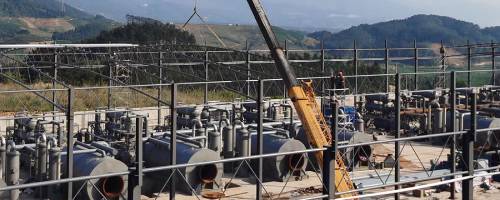Continuous Pyrolysis Plant
Fully automatic continuous waste tire to oil plant is a significant improvement based on the existing intermittent waste tire to oil plant at home and abroad. Fully automatic continuous waste tire to oil plant has fully realized the automatic operation and can prolong life 5-6 year compared to intermittent waste tire to oil plant.
In the early years, the most commonly used pyrolysis plant is mainly the batch operation process, which has low investment but complicated operation process and high labour cost. With the technology improving and customers’ requests, we DOING Company developed a new technology continuous pyrolysis plant. This continuous pyrolysis plant has fully automatic process, which can be controlled by PLC system or computer.
DOING semi-continuous tyre pyrolysis plant is used to recycle waste tires into fuel oil, carbon black, syn-gas, etc. Semi-continuous type pyrolysis plant has higher processing efficiency and higher automation degree.
Waste tyre pyrolysis plant can convert waste tyres into fuel oil, carbon black and steel wire through pyrolysis technology, which can effectively reduce the environmental pollution caused by the accumulation of waste tyres, and at the same time can gain profit by selling the products. Compared with intermittent waste tyre pyrolysis plant, Doing continuous fully automatic waste tyre pyrolysis plant has a lot of advantages.
New design fully continuous waste plastic pyrolysis plant is a process newly developed by Doing Group. It uses a pyrolysis chemical reaction to separate waste solids such as tires, plastics, and rubber into fuel, carbon black, and combustible gases at high temperatures.
No pollution fully automatic waste tyre pyrolysis plant adopts the latest pyrolysis technology.By using our automatic waste tyre pyrolysis plant, you can get tyre oil, carbon black and steel wire from waste tyres. The tyre oil can be widely used as fuel oil in industries such as steel and iron and boiler factories, ceramics, power or chemical industries or hotels, restaurants etc., or used for generators to get electricity.
Through continuous improvement and constant technology upgrading, Doing group has designed the continuous automatic recycling tyre oil plant which can convert tyre into useful resources more efficiently. This continuous automatic recycling tyre oil plant includes DY-30, DY-50 and DY-80 and its the daily processing capacities range from 30 to 80 tons.
Fully continuous waste tire pyrolysis plant can feed and discharge carbon black at the same time, working continuously for 24 hours without stopping. Compared with batch type waste tire pyrolysis plant, workers need to load and process waste tires, plastics and other raw materials in batches, and wait for the reactor to cool and discharge carbon before proceeding to the next batch.
Doing continuous waste plastic to oil machine adopts high temperature pyrolysis technology to realize the process from waste plastic to oil, which is a high-temperature thermal decomposition of materials in the absence of oxygen. During the operation of Doing continuous waste plastic to oil machine, all operations are automated.
Fully continuous waste plastic pyrolysis plant is an environmental protection system which uses the continuous liquefaction technology and catalytic breakdown reaction to convert waste plastics into renewable resources, such as pyrolysis oil, carbon black, combustible gas and so on.
In order to effectively deal with the environmental pollution problems caused by waste tires and waste plastics, Doing engineers specially designed intermittent pyrolysis plant and continuous pyrolysis plant to treat waste tires and plastics to produce fuel oil, carbon black and steel wire after years of research. Both intermittent pyrolysis plant and continuous pyrolysis plant use the pyrolysis principle to dispose of waste tires and plastics environmentally friendly.
Continuous process of plastic into oil machine of technologies aims to present an overview of the technologies available for converting waste plastics into a resource. It emphasizes the typical methods for converting waste plastics into solid, liquid a nd gaseous fuels as well as the di rectcombustion of waste plastics for specific applications.






